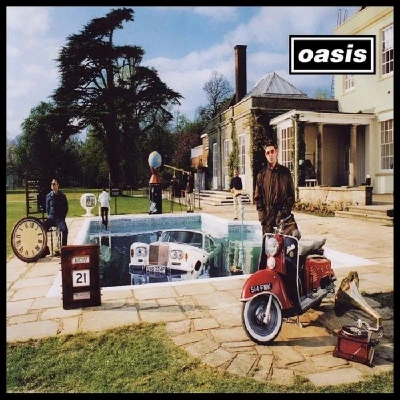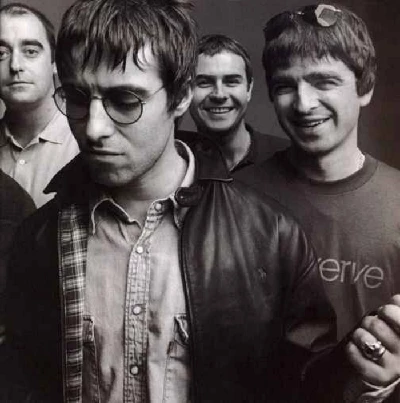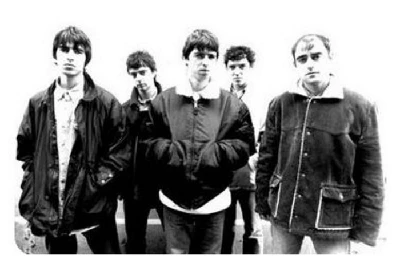Oasis
-
Be Here Now
published: 8 /
11 /
2016

With a 3CD re-issue 'Be Here Now: Chasing the Sun Edition' set for release in October, Richard Lewis, in our 'Re:View' section examines Oasis’ divisive third album issued amid colossal anticipation in 1997 to outstanding reviews only to suffer a huge backlash within months of release
Article
The most heavily hyped, eagerly anticipated, expectation heavy album of all time, Oasis’ third album 'Be Here Now' has become notorious since its release in August 1997. Initially celebrated as the best LP the Manchester band had released up to that point, reviews were universally positive, commending the band for consolidating their career with a modern classic. With the 'NME's 8/10 rating, the now defunct 'Select' awarding it 4/5, 'Uncut' and 'Q' both gifting a full five stars, along with 'Mojo' stating the LP had "masterpiece written all over it", the disc was set to be the definitive album of the year.
Flagged up by an hour long special on BBC1 the night before release, ‘Right Here, Right Now’, proof of the record’s vast commercial success still stands. While Adele officially holds the first-week record for the UK's fastest-selling album with 800,307 copies sold of '25', the figure of 696,000 only for 'Be Here Now' accounts for three days, as the LP was issued on a Thursday due to foreign territories breaking the release embargo. Over seven days Oasis sold more, topping out at 813,000. The first day sales of 'Be Here Now' remains, with 424,000 copies shifted, an outstanding achievement in the pre-Internet era. Yet despite the adulatory notices, massive sales and all-round goodwill towards, the tide quickly turned.
Seven years after its release the album’s de facto creator Noel Gallagher stated during music documentary ‘Live Forever: The Rise and Fall of Britpop’, "‘Be Here Now’ is the sound of a bunch of guys on coke in the studio not giving a fuck. There’s no bass on it at all. I don’t know what happened to that. It’s all crap and all the songs are really long and all the lyrics are shit, and for every millisecond Liam is not saying a word, there’s a fucking guitarist in there in a ‘Wayne’s World’ style, you know, fucking going mental." How could an album released to such enormous success have fallen out of favour so badly?
Wrapped in a cover that featured a raft of pop cultural icons, a Mod scooter, the Rolls Royce in the swimming pool legend created by Keith Moon (who accidentally reversed the car into a pond but was aware enough of his own legend to take a photo of the event), Kurt Cobain’s signature Jag-Stang Fender guitar, the LP artwork self-consciously positioned itself as a classic.
Garlanded with the dubious accolade of "the album that killed the Britpop dream stone dead" by music journalist John Harris in his superlative history of the Britpop movement, ‘The Last Party’ (2002), the former 'NME' writer posits that the bad reaction to 'Be Here Now' was so momentous it effectively killed off a music movement. With Blur, Pulp and Oasis prompting a huge surge in interest around UK bands, the public’s sour reaction to 'Be Here Now' saw scores of lesser bands suddenly become irrelevant.
The stellar reviews for 'Be Here Now' were almost certainly prompted by the critics being proven wrong with their tepid response to ‘(What’s the Story) Morning Glory?’. With an 'NME' ranking of 7/10 and a 'Q' review of 3/5, rock critics gave Blur’s 1995 album ‘The Great Escape’ far greater praise. While the ‘Life Trilogy’ of LPs had worn thin for Blur and ‘The Great Escape’ was thought by the public to be inferior to its predecessor ‘Parklife’, ‘Morning Glory’ sold in huge quantities. With critics as Stuart Macconie puts it in ‘3862 Days: The Official History of Blur’ so desperate to be Oasis’ gang," 'Be Here Now' received unanimous critical adoration on release partially to make amends for their earlier mis-step.
An extra layer of notoriety was added to the release as journalists in possession with a review copy had to sign an agreement that they wouldn’t play the LP or even discuss its contents with their friends or family. Greeted with derision by the press in the following years for what they saw as Oasis’ management company Ignition and their heavy handed tactics, worries about the LP leaking would become weirdly prescient within three years with the advent of peer-to-peer sharing networks and Napster.
With twelve years’ hindsight from the event in a series of interviews to promote career bookending singles collection ‘Time Flies… 1994 – 2009’, Noel Gallagher reflected on the LP. "I guess if you’ve just sold twelve million albums no-one on Creation (the band’s then record company)…their ethos was ‘the artist is always right.' I can’t say it was right though, I can’t listen to any of that album. It’s just too long. I wish I’d edited a bit more quality control on that and edited the songs down." Indeed, with a running time of 72 minutes, 'Be Here Now' could easily have withstood a quarter of an hour being trimmed from the disc without reducing the number of tracks.
Produced by Noel and Owen Morris, replicating the set-up for 'Morning Glory', the latter had been brought in to the Oasis camp in 1994 to bring greater clarity to debut LP 'Definitely Maybe', which he began doing by reducing the huge number of tangled guitar tracks on the LP. As John Harris notes, in this instance Morris increased them, with ferocious rocker 'My Big Mouth#, written as a comment on Noel’s run-ins with the press suffering greatly from its endless overdubbing, reducing the guitar parts to sludge ("Thirty tracks of guitar" Noel boasted to a 'Q' journalist at a LP playback).
The "loudness war", (something which has been curtailed in recent years by YouTube volume standardising), was a new technique in the mid-nineties and was effectively introduced to listeners by Owen Morris with his in-your-face upfront mixes for 'Definitely Maybe'. The practice of ‘brickwalling’, so the meters teeter into the red for the entire track reducing the dynamism between the instruments, made the songs burst out of radio and TV far louder than anything else. The downside of this sonic sleight of hand, however, was to tap the rise and fall of the songs, so any variations in volume were effectively lost.
The sonic overload, while in some respects a commercial decision was according Noel also largely chemical due to his and his brother’s cocaine habits. The songwriter’s assessment of the LP that "there’s no bass on it", saw four-stringer Paul McGuigan’s simple root-note lines while low-key on earlier albums become near inaudible.
Delving into the LP with almost twenty years’ worth of perspective, 'Be Here Now' is not the disaster many believed, yet it is far from the under-rated gem some apologists have tried to talk the album up as. As proof of the audio overkill, lead single 'D'You Know What I Mean?' is presented in remixed form on the set, which is available on the band’s YouTube channel. Sub-titled NG's 2016 Rethink, the redux is vastly superior, minimising the guitar fuzz, giving greater prominence to the bass and most revealingly, amping up the string section that is virtually inaudible on the original. This along with several tracks available in demo form add weight to the theory that 'Be Here Now' was a decent enough collection of songs marred by bad production.
Arguably the poorest track to feature on the first three Oasis albums, ‘Magic Pie’ is a wafer thin melodic conceit stretched out to a tiresome seven minutes. In late September the previous year Oasis had officially announced they were backing the Labour Party with the track featuring an adapted line from Tony Blair, then Leader of the Opposition’s speech, "There are but a thousand days to prepare for the next thousand years." Live, the song fared poorly according to a 'Melody Maker’ review of the band’s Earl’s Court show soon after with a disgruntled Noel asking the audience "What’s wrong? Don’t we deserve some applause?" after a tepid reception to the cut.
The third disc of the set, 'The Mustique Demos', features working versions of the tracks recorded on the ultra-exclusive island where Noel stayed with his then-wife Meg Matthews along with then-couple, actor Johnny Depp and supermodel Kate Moss. The 6:52 running time of the interminable ‘Fade In-Out’ meanwhile is cleverly edited to make the song somehow feel twice the length. Featuring Depp on slide guitar, the most celebrated actor on the planet at the time with his perfunctory skill on the instrument suggested that Ry Cooder could sleep easy at night.
This, along with the aforementioned 'Magic Pie' were played on the 'Be Here Now' tour and never heard in any of Oasis’s live sets ever again. With the exception of 'Stand By Me' which survived in the band’s live sets for another five years and a handful of appearances for 'My Big Mouth' and 'D’You Know What I Mean?' none of the remaining material was played beyond the 'Be Here Now' tour.
Another reason for the album’s dip in quality next to its predecessors was that the well of songs Noel Gallagher had accumulated over the past half-decade was beginning to run dry. As Creation boss Alan McGee stated in Channel 4 documentary ‘There We Were...Now Here We Are The Making of Oasis’ in 2004, "I think he had fifty songs when he met me and he used to lie and told me he’d just written one on the train and I think the guy had been writing for about five years before he met me… and I think he had the first two albums." Noel confirmed this, "I had a lot of time on my hands. I was on the dole. I had fuck all to do other than write songs. I wrote the first three albums in one go really. The best songs were on the first album, then the second album were maybe ones that weren’t as good but worked on and got a little bit better and I wrote a couple of new ones. The third ones, ‘Be Here Now’, were the ones that were left over from all that."
This comment throws light on why at times the tracks on 'Be Here Now' appear to be re-writes of earlier tracks. ‘Stand By Me’ the album’s second single bears more than a passing resemblance to earlier track ‘Married With Children’. The undistinguished ‘I Hope, I Think, I Know’ meanwhile sounds like an early Noel composition like 1994 B-Sides ‘Alive’ and given a supercharged production boost that wouldn’t have sounded out of place alongside early B-Sides like ‘Alive’ and ‘I Will Believe’.
Elsewhere while serviceable ballad ‘Don’t Go Away’ is slightly too saccharine, the pile-driving title track based around a hook created by Noel on a children’s piano on permanent loan from Mick Jagger’s holiday home in Mustique sees the LP regain ground. References to earlier Oasis songs abound here also with Liam adding the "C’mon, Yeah, Yeah, Yeah" hook from Columbia to the final chorus.
'All Around the World' was another early Gallagher composition, dating back to the band’s days rehearsing in The Boardwalk. Spoke of enthusiastically by its writer who stated the song hadn’t been featured on earlier releases as "there isn't enough money in Creation Records' bank balance to pay for the production of that record." Inflating the widescreen rock epic up to ludicrous proportions, featuring two orchestras, a score of backing vocalists including Richard Ashcroft, the key changes shifting up the scale each time were including due to Noel’s theory of how ‘Hey Jude’ would have sounded with the same device included. "Imagine how much better 'Hey Jude' would have been with three key changes towards the end." The Wagnerian enormo-production is probably the one time on the album when the kitchen sink approach was truly justified with a similarly expensive video to boot.
On the plus side ‘The Girl in the Dirty Shirt’, inspired by Meg Matthews and an incident on tour is the one that got away on 'Be Here Now’s, a swaying Beatles-indebted track that while slightly too long deserves a reappraisal. Two of the tracks featured had been debuted at the band’s record-breaking Knebworth Concerts held the previous July the aforementioned ‘My Big Mouth’ and ‘It’s Gettin’ Better (Man!!)’ which instantly found favour with the crowd. Though definitely one of the best things here, the knockabout rock n’ roll of the latter is extended well beyond reason, clocking in at an exorbitant seven minutes when four would have easily sufficed.
Playing as the credits roll with extra orchestral embellishment and more ludicrous drum fills a reprise of ‘All Around the World’. The door slamming at the end of the corridor drawing a line under the LP consciously evoking "the longest chord ever" at the close of ‘A Day in the Life’ from The Beatles’ ‘Sgt. Pepper’.
In view of the public’s gradual indifference to the album Oasis found themselves the victims of circumstance as 1997 saw a raft of classic albums issued by British bands. A group the Mancunians had supported on tour in 1995 before their temporary demise, The Verve re-emerged with their triumphant third album 'Urban Hymns', which went on to easily outsell 'Be Here Now' over the following eighteem months. Radiohead, issuing their third album the same year, arguably reached their career summit with 'OK Computer' scooping overwhelming praise and lasting global fame, for the adventurous, mould-breaking album. Fellow Creation act Primal Scream returned rejuvenated with one of their finest ever LPs ‘Vanishing Point’, while Oasis’s Britpop rivals Blur issued their eponymous fifth album which successfully carved out a post-Britpop gameplan and caught fire commercially, belatedly breaking the Essex troubadours in US with the ubiquitous ‘Song 2’.
While 'Be Here Now' sold at an astonishing rate for its first two months, come December 1997 the LP had slid to the edge of the Top 20 Album Chart, unthinkable for the biggest band in Britain who were failing to clear even greater sales over the lucrative Christmas period. With a chart run of 44 weeks, the record had a vastly shorter lifespan on the Top 100 than marathon runners 'Definitely Maybe' and 'Morning Glory' which both racked up several years individually.
While 'Be Here Now' went on to sell eight million, a highly impressive sales statistic in the present day, its overall sales were roughly a third of those of 'Morning Glory’s' and half of 'Definitely Maybe'. Signalling the end of an era, as no-one could have known at the time, it was the last Oasis LP to be released by Creation Records, which closed for business in early 2000. Noel Gallagher stated in early 1998 meanwhile that "there won’t be another Oasis album in the nineties", as highly regarded B-Sides trawl ‘The Masterplan’ drew a line under the band’s output for the decade in November of that year.
The backlash against the album effectively ended the careers of the lesser Britpop groups on the rungs beneath the present band, Blur and Pulp, as groups who had previously chalked up Top 20 singles gold certified albums almost immediately fell out of favour. The likes of Menswear, Echobelly, Gene, Longpigs and Cast all saw their sales drop dramatically, while beneath them bands who had been signed in the Britpop goldrush were quickly, (some say mercifully) dropped. As Sleeper lead singer Louise Wener stated in a Britpop cover feature for 'Mojo' in April 2003, "Once the bigger bands lurched into crisis, which they did, then all the smaller bands… You know, when Bagpuss goes to sleep, everyone else goes to sleep and that’s when it finished for everybody that came in their wake."
An LP which is bigger than a mere third album, despite its obvious flaws, 'Be Here Now' serves as a time capsule back to the messy end of an era, and a salutary lesson to rampant egos, spiralling drug habits and a music industry desperate to continue the run of success it had hit upon.
'Be Here Now: Chasing the Sun Edition' will be re-released through Sony on 7th October.
Track Listing:-
Band Links:-
http://www.oasisinet.com
https://www.facebook.com/OasisOfficial
http://oasisofficial.tumblr.com/
https://twitter.com/oasis
Picture Gallery:-

